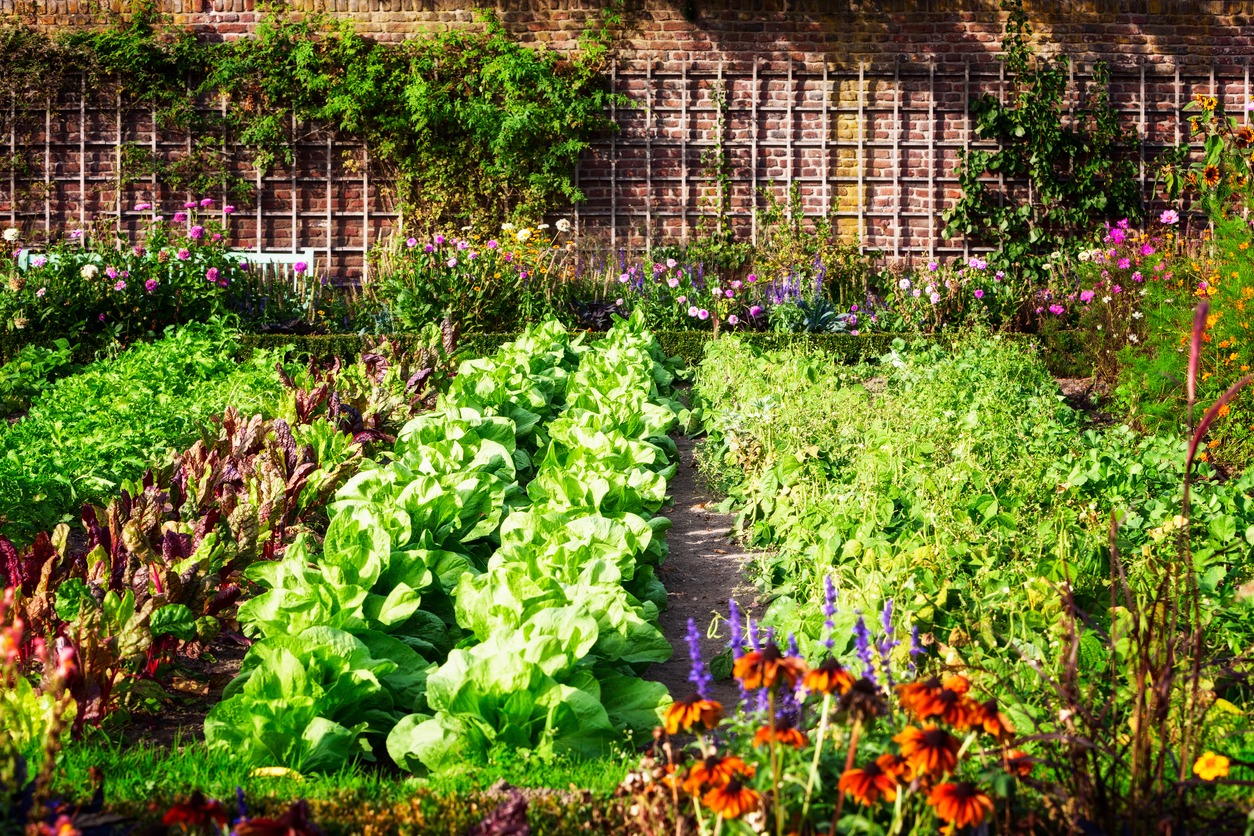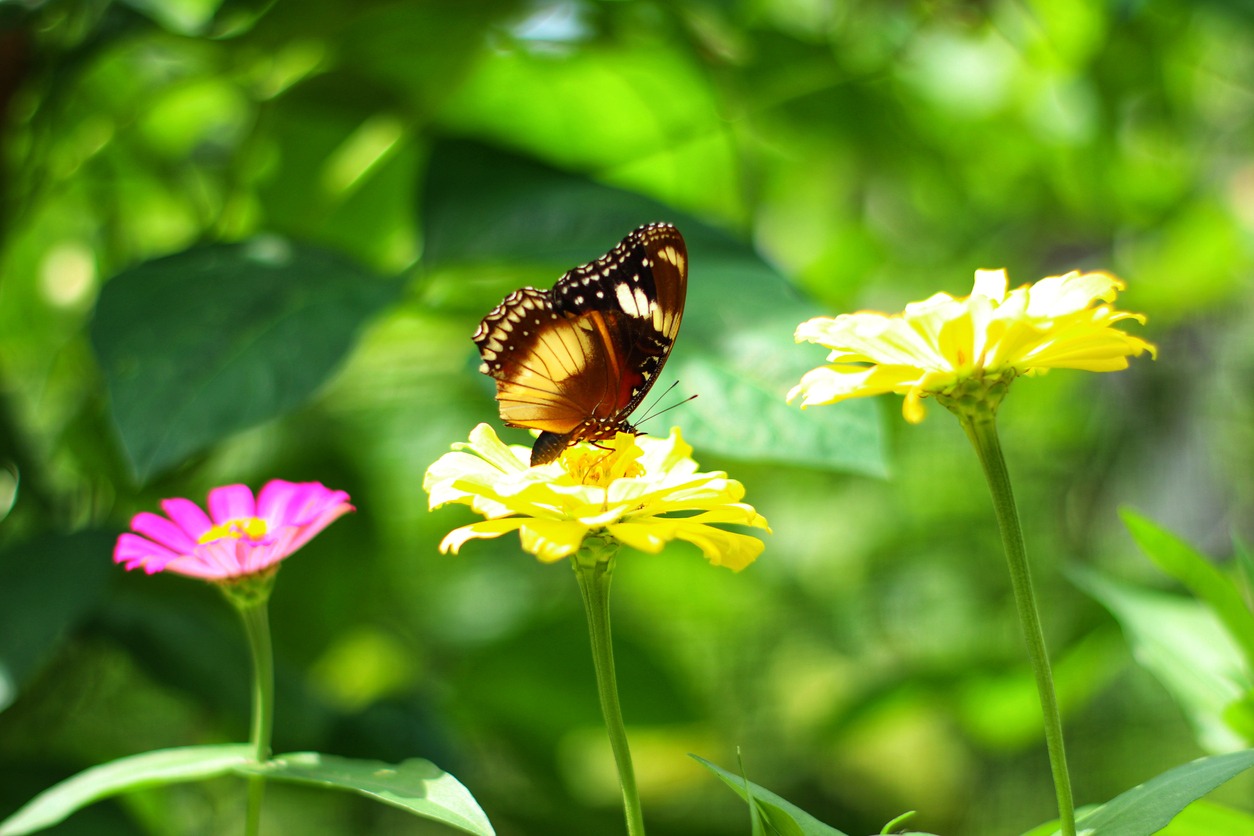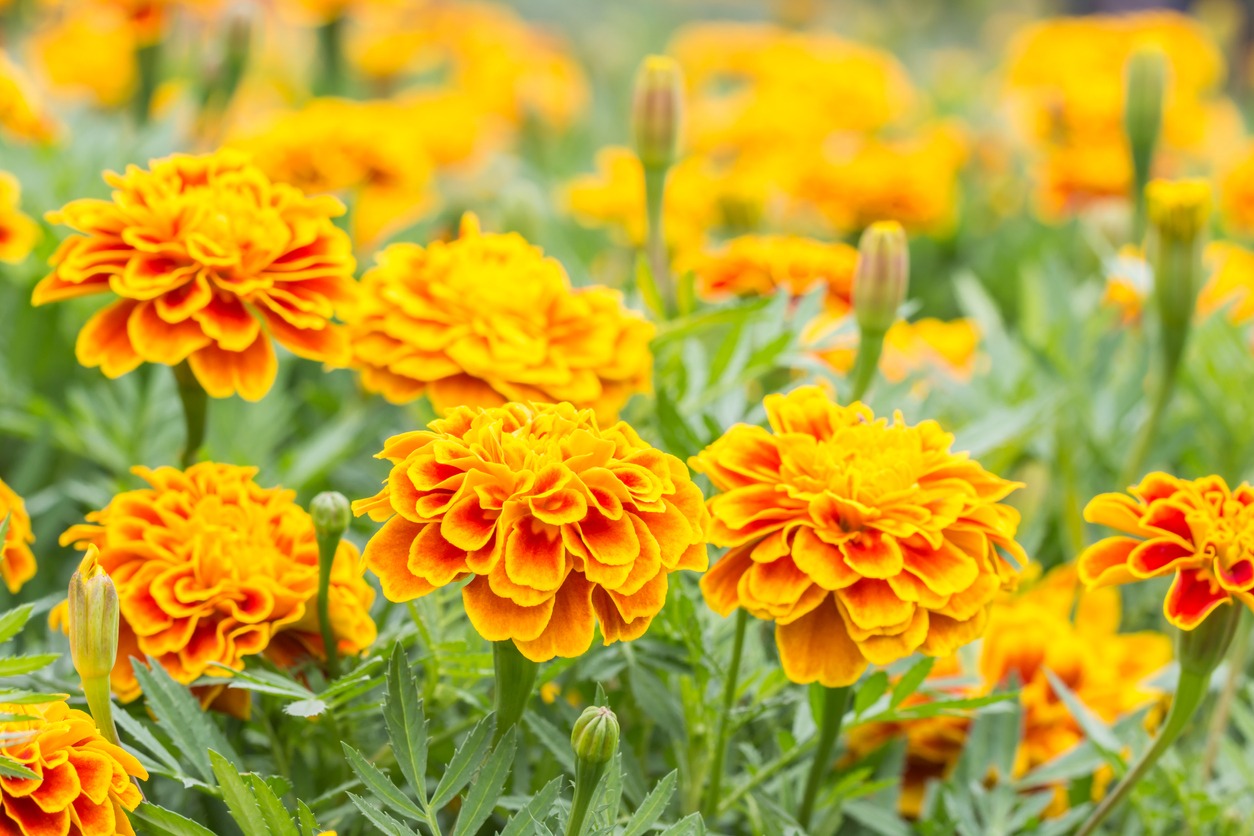Planting flowers in a vegetable garden comes with perks beyond beautification. Flowers can be used in companion planting to attract beneficial pollinators and help deter pests. Flowers can be beneficial for your vegetables, and here are the reasons why:
Flowers can make your vegetable garden look more beautiful
Nothing compares to the allure of flowers when it comes to enhancing the beauty of your garden. Flowers can create a visually stunning landscape with their array of colors, shapes, and sizes. You can use them to line your garden’s borders, fill in empty spaces, or add layers of height and dimension.
Since you’ll be spending a significant amount of time in your vegetable garden, why not make it a place of beauty? By adding flowers, you can elevate the aesthetic appeal and create a delightful environment.
Also, flowers attract wildlife, such as bees, butterflies, and hummingbirds. Their presence adds a lively and captivating aspect to your garden. Watching these creatures flutter from one flower to another is delightful and adds an extra layer of beauty to your garden.
Flowers attract pollinators
One of the most crucial reasons for incorporating flowers into your vegetable garden is pollination. Flowers attract pollinators like bees, butterflies, and hummingbirds, which visit them frequently. As these pollinators move from flower to flower, they unknowingly transfer pollen, which helps fertilize the plants and promote fruit production.
Without pollinators, many vegetable crops would struggle to produce fruits or yield meager harvests. That’s why flowers are essential in your garden, as they serve as magnets for these important insects and animals.
Some vegetables, like tomatoes, peppers, and eggplants, are self-pollinating and do not rely heavily on pollinators. However, even these plants can benefit from the presence of flowers nearby. Flowers attract other beneficial insects that aid in pest control and contribute to soil health.
When choosing flowers for your vegetable garden, opt for varieties that are attractive to pollinators. Marigolds, zinnias, sunflowers, dahlias, calendula, and alyssum are excellent choices. These flowers boast vibrant colors and sweet fragrances that entice bees, butterflies, and other pollinators. By planting them alongside your vegetables, you ensure a fruitful harvest and a thriving garden.
Flowers can function as natural pest controllers
Flowers are nature’s secret weapon in pest control, working in fascinating ways to create a harmonious balance in your garden. These colorful blooms attract beneficial insects like ladybugs, lacewings, mantids, and hoverflies, which feed on common garden pests such as aphids, spider mites, and whiteflies. By planting flowers alongside your vegetables, you can naturally reduce the number of harmful pests without relying on chemical pesticides.
In addition to attracting beneficial insects, certain flowers have developed clever defense mechanisms to deter pests. For instance, marigolds emit a scent that repels nematodes, while chrysanthemums produce a natural insecticide called pyrethrum, which repels a wide range of pests. These flowers act as guardians, safeguarding your crops and reducing the need for harmful chemicals.
Flowers can act as trap crops for pests
Flowering plants can also serve as trap crops, luring insect pests away from your desired vegetable crops. Marigolds, for example, attract slugs, snails, and nematodes, diverting them from plants like potatoes, tomatoes, beans, and cucumbers. Nasturtiums, on the other hand, entice aphids, a common threat to vegetables and ornamental plants. These flowers protect your precious crops from infestations by sacrificing themselves as decoys.
It’s important to remember that after harvesting your vegetables, you should uproot and destroy these trap crops. If left unattended, they can become breeding grounds for pests and diseases, no longer able to resist their invasions. Taking these precautions ensures a healthy garden environment.
Flowers can help improve soil structure
Some flowers, like marigolds, have deep roots that break up compacted soil, allowing better airflow and water penetration. Their roots anchor the soil, preventing it from washing away during heavy rainfall or strong winds. By planting flowers in your garden, you create a natural defense against erosion, preserving the integrity of your soil. As erosion is prevented, flowers help promote healthier plant growth in your vegetable garden.
Flowers act as nitrogen fertilizers
Atmospheric nitrogen is abundant but inaccessible to plants. However, certain plants, known as legumes, form a partnership with nitrogen-fixing bacteria in their roots. Lupine is an example of a beautiful flowering plant that enriches the soil by fixing atmospheric nitrogen. In this symbiotic relationship, the bacteria extract nitrogen from the air while the plants provide them with shelter and energy. Lupine, in addition to its aesthetic appeal, acts as a free nitrogen fertilizer, benefiting both the soil and the plant.
Flowers help suppress weeds
Some flowers can release chemicals into the soil that inhibit the growth of weeds, helping to control their spread. This kind of flowering plants grows densely and low to the ground, creating a natural ground cover. It prevents weed growth by shading the ground and leaving no room for weeds to thrive. Examples of such plants include candytufts, yellow rattle, creeping phlox, dead nettle, and nasturtiums. These flowering ground covers control weeds and require minimal maintenance, making them an excellent choice for your garden. By incorporating flowers in your garden, you can reduce the need for manual weeding and maintain a neat and tidy garden.
Beneficial Flowering Plants to Add to Your Vegetable Garden
If you want to make use of flowers as a companion plant for your vegetable garden, here are the flowers you may want to consider:
1. Marigolds
Marigolds are reliable and resilient annual flowers that are perfect for your garden. They are easy to grow from seed and are not bothered by pests or diseases. Marigolds are not picky about soil and can thrive in the ground and containers. It’s no wonder they are considered a classic flower in the vegetable garden.
Marigolds come in various heights and petal sizes, ranging from 6 inches to 3 feet in height and 2 to 5 inches in petal diameter. There are different types of marigolds, such as:
- French marigolds – These are dwarf and bushier, offering solid or multi-colored flowers that bloom from spring until the first frost.
- African marigolds – These are tall with double pom-pom flowers in vibrant shades of yellow and orange. Triploid marigolds – A cross between French and African varieties
- Signet marigolds – These are bushy plants with delicate foliage and single flowers. Signet marigolds are edible.
One of the remarkable benefits of companion planting marigolds is their ability to repel pests in specific plant families. For example, marigolds have been shown to repel cabbage butterflies and moths in the Brassicaceae family (including kale, broccoli, and cabbage). They also provide a protective effect on plants like eggplants, green peppers, and daikon during their early growth stages. Additionally, marigolds can help deter onion flies from laying eggs on onions.
If you have tomatoes in your garden, marigolds are a fantastic companion. They not only add a splash of color but also attract pollinators like bees, ensuring a better fruit set. What’s more, marigolds repel nematodes, slugs, hornworms, and other garden pests that can harm your tomatoes. Their strong scent can also mask the smell of your vegetables, confusing and deterring pests from attacking them.
2. Nasturtium
Nasturtiums are annual plants that not only bring vibrant colors to your garden but also produce edible flowers. They come in two main growth habits: bush-type and vining. If you have limited space, opt for a dwarf bush-type variety, while vining varieties are suitable for larger areas.
Planting nasturtiums alongside zucchini can help reduce damage from squash bugs, providing a natural defense for your zucchini plants. Also, they can act as sacrificial hosts for the white cabbage butterfly. By planting nasturtiums around cabbage, broccoli, kale, and other brassicas, you can divert the attention of these pests away from your main crops.
Nasturtiums offer some protection against squash bugs and beetles, making them a valuable asset in your garden. While they may attract aphids, they can also act as a trap crop, diverting these pests away from your other plants. It’s worth noting that nasturtium flowers and leaves are delicious and edible, so don’t sacrifice them all to the insects.
3. Cilantro
Cilantro is a delightful addition to any garden, especially if you enjoy Mexican dishes. It produces fragrant and spicy leaves, followed by small white flowers. These flowers eventually turn into round seeds known as coriander. The beauty of growing cilantro is that you can harvest both the leaves (cilantro) and the seeds (coriander).
When interplanted with eggplant, cilantro can help control the Colorado potato beetle by attracting beneficial insects that prey on these pests. It can also help control caterpillars as it attracts parasitic wasps. Also, it’s good to interplant cilantro with brassica crops like cabbage, as it can effectively deter cabbage worms.
As a flowering herbaceous plant, cilantro attracts pollinators and beneficial insects to your garden, enhancing the overall ecosystem. Additionally, its deep-reaching roots can help loosen the soil, reducing the need for extensive tilling.
4. Lavender
Lavender is a versatile and delightful addition to any garden, offering numerous benefits and uses. Its light, delicate flowers, and pleasant fragrance make it ideal for creating a hedge around your vegetable patch.
One of the great advantages of lavender is its ability to repel animals like deer and rabbits, helping to protect your precious vegetables. Additionally, lavender acts as a natural deterrent for insects such as ticks and moths, reducing their population in your garden. On the flip side, the enticing scent of lavender attracts beneficial insects like butterflies and bees, making it a valuable flower to have in your vegetable garden.
When it comes to companion planting, lavender proves to be an excellent partner for vegetables like Brussels sprouts, cabbage, cauliflower, broccoli, and celery. Its presence can help deter pests and create a harmonious environment for your vegetable crops.
5. Sweet Alyssum
Sweet alyssum is a charming annual plant that grows in a low mound, reaching a height and width of up to 12 inches. Its small flowers come in white, pink, or purple and emit a delightful honey fragrance. These flowers have the special ability to attract beneficial insects like butterflies and bees to your garden.
Planting sweet alyssum along the edges of a lettuce bed can attract parasitic wasps, which are helpful in controlling aphids. Also, you can grow sweet alyssum around carrot plants to deter pests that lay eggs in the soil, protecting your carrots.
6. Calendula
Calendula is a beautiful flower that brings a vibrant burst of orange and yellow to your vegetable garden. It’s an annual plant that requires minimal care and can grow to a height of 1-2 feet. The great thing about calendula is that it continues to thrive well into the fall and even self-seeds, popping up in the same spot each year. Not only is calendula visually appealing, but it’s also an edible herb with spicy leaves and flowers.
As a companion plant, calendula can be useful. It attracts aphids, making it a useful trap plant to divert these pests away from your other crops. Also, planting calendula in your garden will attract beneficial insects like ladybugs, hoverflies, and lacewings, which help control unwanted pests.
Although calendula may attract aphids, you can strategically use it as a trap crop by placing it away from plants that aphids commonly target, such as peas. This way, calendula can lure the aphids away from your desired crops.
7. Sunflowers
Sunflowers are a fantastic choice if you want to invite bees and other pollinators into your garden. These cheerful, sun-loving giants play a vital role in improving pollination for your fruits and vegetables by offering the bees a rich source of nectar and pollen.
In addition to their pollinator-attracting qualities, sunflowers serve as excellent companions for climbing crops like cucumbers, beans, peas, and squash. You can train these vine plants to grow alongside the sturdy stalks of the sunflowers, creating a natural and sturdy trellis.
But the benefits don’t stop there. Sunflowers can also provide much-needed shade for delicate greens like spinach and lettuce, which tend to bolt when exposed to excessive sunlight.
What’s even more impressive is that sunflowers have the ability to cleanse your garden soil. Through a process called phytoremediation, they absorb toxins such as metals, pesticides, solvents, and gasoline from the ground, making the soil healthier and more suitable for growing your vegetables.
However, it’s important to note that after the phytoremediation process, the sunflowers themselves become toxic. To ensure the safety of your garden, it’s necessary to remove and replace them once they have fulfilled their cleansing purpose.
8. Sweet pea
If you’re in need of a companion for your leafy greens, look no further than sweet peas.
Sweet pea flowers bring a burst of vibrant colors to your vegetable garden, adding beauty to the surroundings. Not only are they visually appealing, but their delightful fragrance also helps mask the scent of vegetables, making it harder for pests to locate them. This makes sweet peas one of the top flower choices for your vegetable garden.
Sweet peas have the remarkable ability to fix nitrogen in the soil. This makes them an ideal companion for leafy greens such as spinach, lettuce, and brassicas, as these vegetables thrive on nitrogen-rich soil.
Growing sweet peas alongside tall, edible pea plants and pole beans allow you to make the most of your garden space while attracting more pollinators to benefit your beans. Sweet peas will not cross-pollinate with edible peas, as they belong to different genera.
9. Cosmos
Cosmos is a flower that thrives effortlessly and produces abundant blooms. What’s great about the cosmos is that these blooms serve a practical purpose in the vegetable garden by attracting a variety of beneficial insects.
If you’re looking to attract green lacewings, opt for a white or bright orange variety like ‘Cosmic Orange.’ Green lacewings are incredibly helpful insects as they have hearty appetites and feed on soft-bodied pests such as aphids, scale insects, and thrips. By inviting green lacewings into your vegetable garden, you can effectively control pest problems.
10. Zinnia
Zinnia flowers are a favorite among bees, other pollinators, and even hummingbirds, thanks to their nectar-rich blooms. If you’re dealing with Japanese beetles, the paler and pastel varieties of zinnia can act as trap crops, attracting these pests away from your other plants. However, it’s important to note that planting zinnias specifically for Japanese beetles may not be necessary unless you already have an existing beetle problem.



